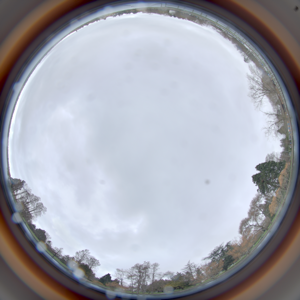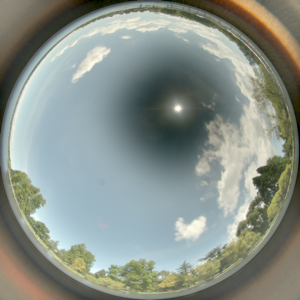TAPESTRY: The Art of Representation and Abstraction
Lighting: Environment Lights
All the world's a light sourceWhat's it all about?
 January noon (overcast) |
 June noon (clear) |
Much of the light which illuminates us and our buildings comes from the sky dome (but not the sun) or from lawns, trees, and buildings around us. Until recently, there was no good way to know how much light there was, or how to include it in a rendering. We could include digital images of the environment, but they told us more about color than light intensity. With the growing adoption of High Dynamic Range (HDR) Images, we now have the needed information.
HDR vs. LDR
Normal (low dynamic range) images are captured by (digital or chemical) processes sensitive to the amount of light present, an susceptible to overloading (over-exposure). As a consequence, on bright days we use a faster shutter speed, while in low light settings we leave the shutter open longer to compensate. This means that the bright parts of our dim image may "saturate" (overload) the sensor, while the dim parts of our bright image may not register.
High dynamic range (HDR) images are captured by taking several pictures with different shutter speeds and f-stops, allowing us to capture more data about the dim parts of the image (in the longer-exposure shots) and bright parts (in the short-exposure shots). In effect, the set of images captures, or samples, the scene in front of the camera, measuring the amount of light energy coming from each part of the scene. With a fish-eye lens, an upward facing camera can capture the entire skydome. More and more software is able to use that data (it's so much more than an 'image') to perform rendering.
Downloading the sky
Our own Professor Mehlika Inanici is one of the major researchers in the emerging area of HDR imagery. The two HDR skydomes shown above were taken by her, and are available for you to use. The files are BIG (24.5MB each).
Vocabulary Caution!
(LDR) images of the environment continue to be useful as backgrounds (or textures) for renderings. They don't contribute light to the scene, just context. Images can also be used to answer the "what's reflected in the shiny bits?" question (that may seem a little counter-intuitive). In both cases, they may be called "environment maps" or something similar.
Last updated: November, 2017
